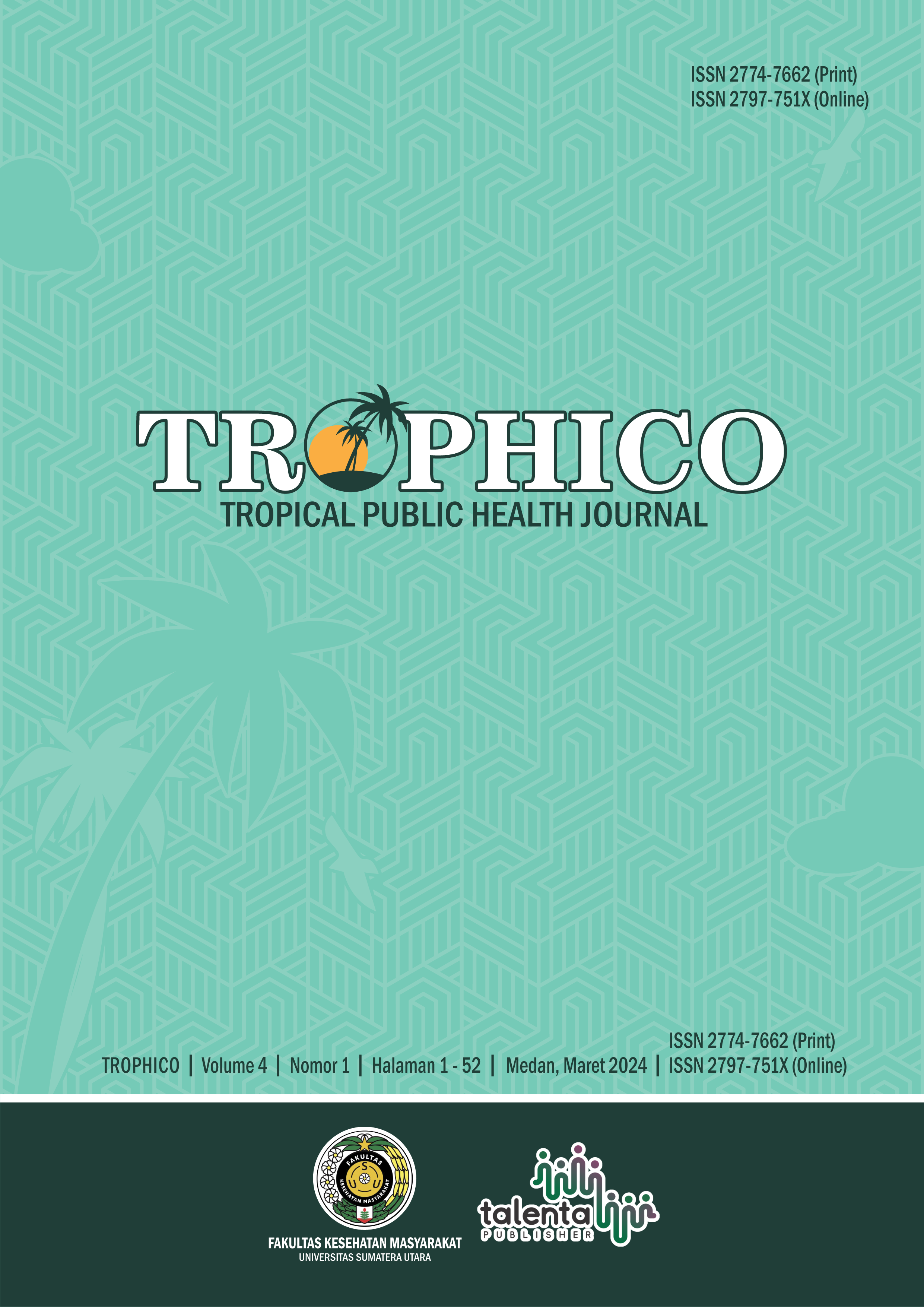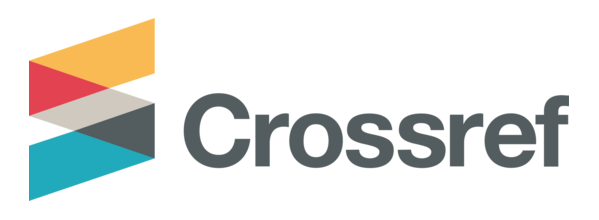Hubungan faktor metabolik dan konsumsi makanan minuman manis dengan kadar gula darah pada usia 30-60 tahun di Puskesmas Simalingkar
DOI:
https://doi.org/10.32734/trophico.v4i1.14534Keywords:
blood glucose levels, metabolic factor, sweet foods and beveragesAbstract
High blood glucose levels (hyperglycemia) can be caused by several conditions, including diabetes mellitus (DM). Among the top 5 nations in the world with the most DM cases in 2021 is Indonesia. There are 161,267 DM patients in North Sumatra, with 31,482 cases in Medan. Simalingkar Community Health Center is one of the health centers in Medan with the highest number of DM cases in 2022. This study intends to examine the association between blood glucose levels in individuals aged 30 to 60 at Simalingkar Community Health Center and metabolic variables, particularly obesity as assessed by body mass index (BMI) and belly circumference, as well as the consumption of sugary foods and beverages. This research is a cross-sectional study. 120 participants were included in this research sample and use accidental sampling method. Data analysis was done univariately, bivariately using the chi-square test and multivariately using logistic regression. The results showed that BMI (RP=1.701; 95% CI=1.095–2.645; p=0.022), abdominal circumference (RP=2.124; 95% CI=1.253–3.600; p=0.003) and sweet foods and beverages consumption (RP=2.042; 95% CI=1.358–3.069; p=0.001) were significantly associated with blood glucose levels. The habit of consuming sweet foods and drinks is the most dominant factor influencing a person to experience hyperglycemia (OR=3,345; 95% CI=1,512-7,387). The community is advised to control blood glucose levels by maintaining ideal body weight and reducing consumption of sweet foods and beverages to prevent type 2 DM.
Downloads
References
ADA. (2022). Classification and diagnosis of diabetes : standards of medical care in diabetes — 2022. Diabetes Care, 45(1), 17–38.
Adwinda, M. D., & Srimiati, M. (2019). Hubungan lingkar perut, konsumsi gula dan lemak dengan kadar glukosa darah pegawai direktorat Poltekkes Kemenkes Jakarta II. Nutrire Diaita: Jurnal Gizi - Dietetik, 11(1), 7–17.
Agrawal, N., Kumar Agrawal, M., Kumari, T., & Kumar, S. (2017). Correlation between body mass index and blood glucose levels in Jharkhand population. International Journal of Contemporary Medical Research, 4(8), 1633–1636. www.ijcmr.com
Al-Goblan, A. S., Al-Alfi, M. A., & Khan, M. Z. (2014). Mechanism linking diabetes mellitus and obesity. Diabetes, Metabolic Syndrome and Obesity: Targets and Therapy, 7, 587–591. https://doi.org/10.2147/DMSO.S67400
Astuti, I. D. W., Maryanto, S., & Pontang, G. S. (2018). The correlation between consumption of sweetened beverages and physical activities with incidence of diabetes mellitus in 30-50 years old at Nyatnyono Village Semarang Regency. Jurnal Gizi Dan Kesehatan, 10(24), 132–141.
Bano, G. (2013). Glucose homeostasis, obesity and diabetes. Best Practice and Research: Clinical Obstetrics and Gynaecology, 27(5), 715–726. https://doi.org/10.1016/j.bpobgyn.2013.02.007
Darsini, & Purwanto, F. (2023). Studi korelasi lingkar perut dengan kadar gula dalam darah. Jurnal Pengembangan Ilmu Dan Praktik Kesehatan, 2(3), 141–153.
Dewi, P. S. L., & Dwipayana, I. M. P. (2022). Correlation between visceral fat, muscles mass, and blood sugar levels in adults. Hang Tuah Medical Journal, 20(1), 86–94.
Dinas Kesehatan Provinsi Sumatera Utara. (2020). Profil kesehatan Provinsi Sumatera Utara tahun 2020.
Harahap, A. M., Ariati, A., & Siregar, Z. A. (2020). Hubungan indeks massa tubuh dengan kadar gula darah pada penderita diabetes mellitus di Desa Sisumut, Kecamatan Kotapinang. Ibnu Sina: Jurnal Kedokteran Dan Kesehatan - Fakultas Kedokteran Universitas Islam Sumatera Utara, 19(2), 81–86. https://doi.org/10.30743/ibnusina.v19i2.44
IDF. (2021). International Diabetes Federation Diabetes Atlas 10th Edition. In Diabetes Research and Clinical Practice (10th ed., Vol. 102, Issue 2). IDF. https://doi.org/10.1016/j.diabres.2013.10.013
Kemenkes RI. (2013). Laporan Nasional Riset Kesehatan Dasar 2013.
Kemenkes RI. (2015). Pedoman umum pengendalian obesitas. In Kementrian Kesehatan RI.
Kemenkes RI. (2018). Laporan Nasional Riset Kesehatan Dasar 2018. In Badan Penelitian dan Pengembangan Kesehatan.
Neuenschwander, M., Ballon, A., Weber, K. S., Norat, T., Aune, D., Schwingshackl, L., & Schlesinger, S. (2019). Role of diet in type 2 diabetes incidence: umbrella review of meta-analyses of prospective observational studies. BMJ, 365(12368), 1–19. https://doi.org/10.1136/bmj.l2368
Perkeni. (2021). Pedoman pengelolaan dan pencegahan diabetes melitus tipe 2 di Indonesia 2021. PB. Perkeni.
Radhina, A., Sari, M. P., & Jannah, I. F. (2023). The relationship between random blood glucose and total cholesterol levels against body mass index in residents of RW O1 Gang Anwar, East Jakarta. Indonesian Journal of Health Science, 3(2), 381–387.
Septyaningrum, N., & Martini, S. (2014). Lingkar perut mempunyai hubungan paling kuat dengan kadar gula darah. Jurnal Berkala Epidemiologi, 2(1), 48–58.
Siregar, F. A., Asfriyati, & Makmur, T. (2022). Sociodemographic and lifestyle-related risk factors for type 2 diabetes mellitus: targeted to prevention. Southeast Asian Journal of Tropical Medicine and Public Health, 53(Supplement 2), 52–64.
Syauqy, A., Mattarahmawati, S. A., & Pramono, A. (2022). Food consumption in relation to hyperglycemia in middle-aged adults (45−59 years): A cross-sectional national data analysis. Jurnal Gizi Dan Pangan, 17(3), 187–194. https://doi.org/10.25182/jgp.2022.17.3.187-194
Veit, M., van Asten, R., Olie, A., & Prinz, P. (2022). The role of dietary sugars, overweight, and obesity in type 2 diabetes mellitus: a narrative review. European Journal of Clinical Nutrition, 76(11), 1497–1501. https://doi.org/10.1038/s41430-022-01114-5
Veridiana, N. N., & Nurjana, M. A. (2019). Hubungan perilaku konsumsi dan aktivitas fisik dengan diabetes mellitus di Indonesia. Buletin Penelitian Kesehatan, 47(2), 97–106. https://doi.org/10.22435/bpk.v47i2.667
Weiss, R., Santoro, N., Giannini, C., Galderisi, A., Umano, G. R., & Caprio, S. (2017). Prediabetes in youths: mechanisms and biomarkers. The Lancet Child and Adolescent Health, 1(3), 240–248. https://doi.org/10.1016/S2352-4642(17)30044-5
WHO. (2018). Noncommunicable diseases country profiles 2018.
Downloads
Published
How to Cite
Issue
Section
License
Copyright (c) 2024 Tropical Public Health Journal

This work is licensed under a Creative Commons Attribution-ShareAlike 4.0 International License.



















